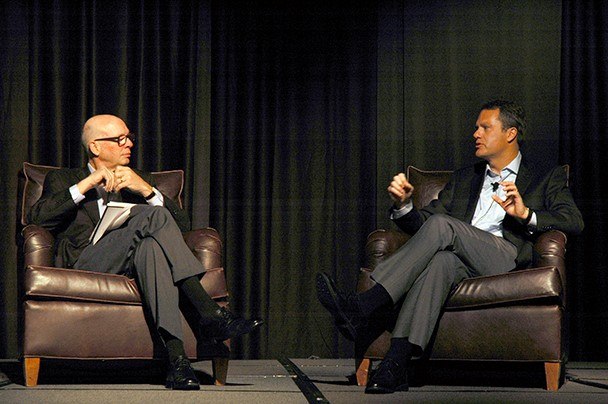McMillon Talks Wages, E-Commerce At Retail Event in Springdale
by June 11, 2015 1:01 pm 260 views

Wal-Mart Stores Inc. CEO Doug McMillon on Thursday discussed the company’s decision to raise its starting wage and continued investment in e-commerce at the 15th annual Emerging Trends in Retailing Conference at the Northwest Arkansas Convention Center in Springdale
The yearly event is put on by the Walton Center for Retailing Excellence, in the Sam M. Walton College of Business at the University of Arkansas.
In the wake of the company’s most recent shareholders meeting (June 5) and a reported drop in profit for the quarter that ended April 30, McMillon said Walmart will likely, during the next two years, feel the financial effects of raising its starting wage.
The wage raise was announced in February, and the company got the ball rolling earlier this spring with a bump up to $9 per hour for newly hired employees. The company’s plan is to raise all wages to at least $10 per hour by next February.
McMillon recalled a pivotal moment in his realization that the wages needed to be raised.
“I was at a store in Denver, talking to a store manager and associates on how to make things better, and the manger pointed to a small food trailer in the parking lot, and he said, ‘They pay $10 an hour to start, and we pay $9,’ and I’m like, ‘That doesn’t need to happen,’” McMillon said.
Walmart made the decision years ago to focus on leveraging costs in order to boost income. “We were leaning into that curve … but sometimes we go too far. We went too far and found ourselves in a ditch on the side of the road. Now, we’re trying to steer back to the middle of the road, without falling into a ditch on the other side,” he said.
McMillon also said Walmart U.S. strayed from the company’s defining low-price advantage in recent years. For that, “We need a large number of true believers.”
In designing its price algorithms, Walmart focuses on consistent prices, in addition to low prices, in an effort to bolster trust with customers, he said. “Customers are smart and they know prices.”
“EDLP [everyday low prices] builds trust, but the Internet’s changed everything,” McMillon said. Walmart will continue to focus on e-commerce, and in the next few years it will continue to grow that part of its business, with much more focus on mobile, working toward a more seamless experience between online and brick-and-mortar shopping.
Walmart now offers a breadth of products — approaching 10 million — online that would never be feasible to place in stores, he said.
But while the store continues its investment in e-commerce, “The Supercenter is not dead,” McMillon said.
However, he added there is room for improvement in many stores.
During the conference, McMillon took questions from the audience and was also interviewed by Richard Smucker, CEO of The J.M. Smucker Co., who asked about Walmart’s decision to build a large number of Neighborhood Markets that potentially end up in competition with each other.
“We’ve always had a willingness to cannibalize our sales,” McMillon said. “But we also have to manage our capital and be good stewards of that.”
The Emerging Trends event including a number of speakers including Andy Murray, senior vice president of creative and customer experience for Walmart, and Judith McKenna, executive vice president and chief operating officer of Walmart U.S.
